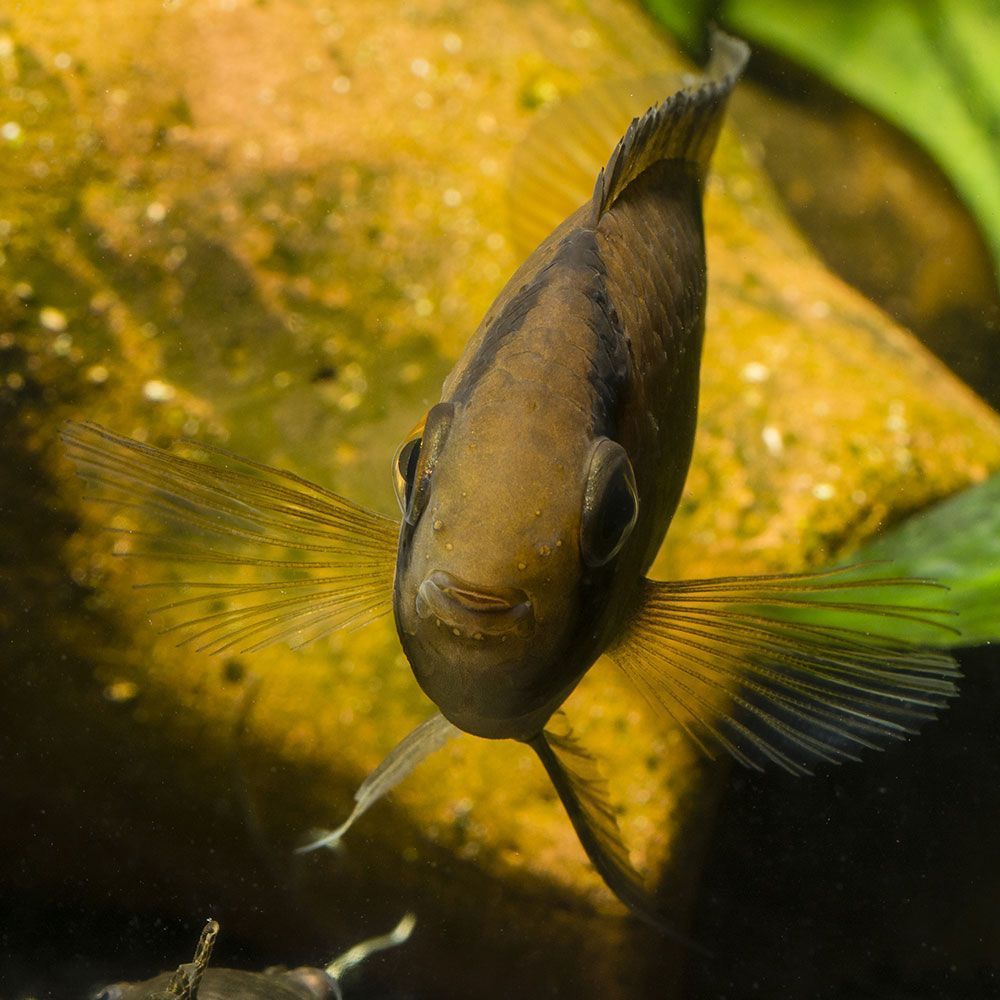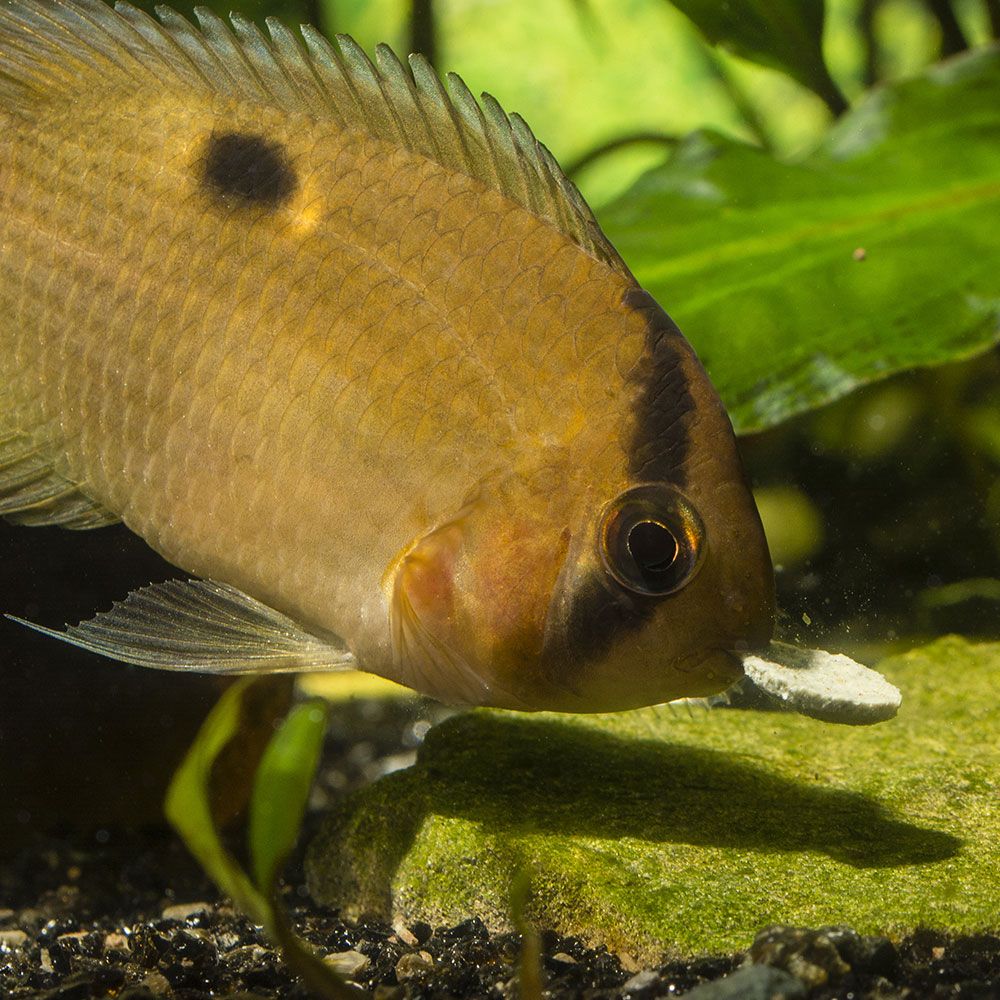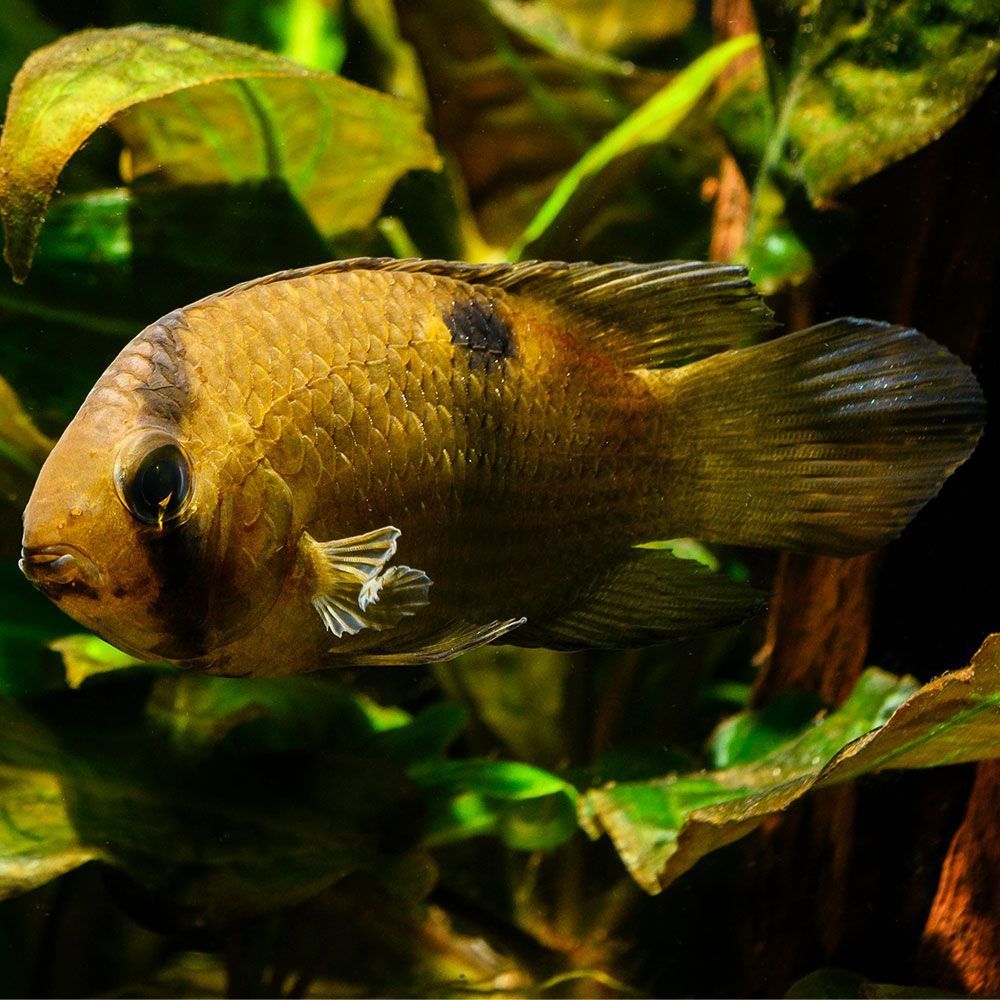If you want to put a gentle-tempered fish in your freshwater community tank, with a relatively longer lifespan, a keyhole cichlid is your go-to answer. This is an amazing addition if you already have lots of colorful species, as its muted tones balance out the overall tank appearance.
The fish also has pretty interesting camouflaging abilities, which will surely leave you spellbound.
So, if you’re ready to bring this fish home, let’s get down to the details!
What is a Keyhole Cichlid?
Keyhole Cichlid is a freshwater fish which is loved by the fish keepers for its long life span and muted color tones.
| Origin | Orinoco River basin, Trinidad; Barima River, Guyana; Ouanary River, French Guiana, South America |
| Order | Perciformes |
| Family | Cichlidae |
| Scientific Name | Cleithracara maronii |
| Common Names | Keyhole cichlid, keyhole |
| IUCN Red List Status | Not Evaluated |
| Appearance | Yellowish cream oval body, round forehead, keyhole-like spot on the flank |
| Size | In captivity, up to 10 cm (3.9 in) for males and up to 8 cm (3.15 in) for females; Up to 15 cm (5.9 in) in the wild |
| Lifespan | Usually up to 6-10 years, 15 years with the best care |
| Temperament | Usually peaceful and shy; Aggressive and territorial during breeding |
| Tank Level | Bottom and middle dwellers |
| Water Temperature | 70-78 °F (21-26 °C) |
| pH Level | 5.5-7.5 |
| Water Hardness | Up to 15 dGH |
| Care Level | Intermediate |
| Minimum Tank Size | 30 gallons for 2, 55 gallons for 3, 125 gallons for 6-8 or a community tank |
| Tank Environment | Spacious tank with lots of hiding space, soft substrate, and pristine water conditions |
| Diet | Omnivorous, carnivorous tendencies, scavenger |
| Tank Mates | Own school (if young) or mated pair (if adult), other similar-sized, peaceful, schooling species |
What is the Natural Habitat for Keyhole Cichlid?
The keyhole cichlid is native to South American countries like Guyana, French Guiana, Trinidad and Tobago, Venezuela, and Surinam.
In these regions, it is specifically spotted in the delta of the Orinoco River basin and rivers from the Ouanary River and Barima River. You can find them in the creeks of the clear and slow-flowing waters of the coastal area.
The fish also stays near decaying wood and logs. So, whenever it gets the signs of predators, it sticks to those and camouflages itself by adapting the substrate color.
Which family of fish does Keyhole Cichlid belong?
The species is housed under the Cichlidae family of Perciformes order. Its binomial name is Cleithracara maronii, whereas it is mainly known worldwide by the name keyhole cichlid or just keyhole.
However, it also has many names in the local language where it’s naturally available.
Fun Fact: Keyhole cichlid is the only species under the genus Cleithracara. So, it’s called a monotypic genus.
How does a Keyhole Cichlid look?

Now, if you’re curious about the looks or antics of this fish, then keep reading!
What is the Size of Keyhole Cichlid?
The adult male keyhole cichlid can grow up to 10 cm (3.9 in) in captivity. Captive-bred adult female fish can be as long as 8 cm (3.15 in). However, the species is known to reach up to 15 cm (5.9 in) in the wild.
What is the Color of Keyhole Cichlid?
The usual base body color of the keyhole cichlid is beige or yellowish cream, but the fin colors may vary from specimen to specimen.
The young fish is more brightly colored, and the body color becomes more subdued as it grows.
This species has a dark stripe running from its dorsal base through the eyes, and right at the base of its gill cover. Around the middle region of its body, on the upper flank, it flaunts a dark spot that looks like a keyhole, and thus its name!
What are the Features of Keyhole Cichlid?
The keyhole cichlid has a much more obvious oval body than other cichlids. This fish has a rounded forehead and long and slender dorsal and anal fins.
It has a slow growth rate, and a 1-inch young fish can take more than 6 months to reach 2 inches length.
When it feels insecure, it can camouflage itself to match the hue of its surroundings. It may also stretch the “keyhole” marking across its body.
The species is a great swimmer and can pick a speed of around 60 miles an hour.
How does a male and a female Keyhole Cichlid differ?
The male keyhole is physically larger than the female keyhole. The male also has more pointed fins and longer dorsal and anal fin rays.
What is the Behavior & Temperament for Keyhole Cichlid?
Generally, the keyhole cichlid is shy and minds its own business. It rather gets scared easily by human activity or lively fish in the aquarium.
However, during the mating season, the fish becomes pretty aggressive and territorial. Both males and females become protective of their nesting areas.
What is the Lifespan of Keyhole Cichlid?
In captivity, most people can sustain the fish for about 6-10 years, but it varies depending on the care and vigilance. However, in my experience, proper vigilance with the water parameters can extend its lifespan to 15 years.
Author’s Note: You can easily tell if the fish is stressed by its color, as it transitions to a brown and blotchy shade.
How to take care of Keyhole Cichlid?

If you can’t wait to befriend this fish, keep reading to learn about its care guide.
What is the Tank Size for Keyhole Cichlid?
If you want to get a pair of keyhole cichlids, a 30-gallon tank works best. If you get 3 of them, invest in a 55-gallon tank.
If you want a small group of 6-8 of them or build a community tank, you need at least a 125-gallon tank.
What is the Water Chemistry for Keyhole Cichlid?
The most important factor in a fish’s lifespan is water. So, try to maintain the best water conditions by following these:
- pH Levels: 5.5-7.5
- Water Temperature: 70-78 °F (21-26 °C)
- Water Hardness: Up to 15 dGH
- Carbonate Hardness: Up to 20 dKH
- Ammonia: 0 ppm
- Nitrite: 0 ppm
- Nitrate: Below 20 ppm
What is the Tank Environment for Keyhole Cichlid?
Your next task is to prepare what goes into the aquarium to make your keyholes feel cozy and at home. So, let’s start with the…
What is the Substrate needed for Keyhole Cichlid?
Soft sand is the best substrate for a keyhole to mimic its natural environment. It will protect the fish from getting cuts while exploring the tank bottom.
Which Plants are best to go with Keyhole Cichlid?
You can go all out with a heavily vegetated tank for this fish. The keyhole cichlid doesn’t dig sand and won’t uproot or eat your plants. Instead, the fish loves to swim among the plants.
So, you can use Anubias, Hornwort, Cabomba, or Java ferns to spruce up your tank.
What type of Lighting is required for Keyhole Cichlid?
Keyholes don’t appreciate direct, harsh, or bright lighting. So, other than dim light, you can also add floating plants to disperse the light.
Which Décor does Keyhole Cichlid require?
The best additions for your keyhole cichlid tank are ceramic flower pots, driftwood, leaf litter, birchwood, branches, ceramic tubes, coconut shells, and caves for shelter. You can also add flat waterworn smooth rocks as spontaneous spawning sites.
What type of Filter does Keyhole Cichlid need?
Use a reliable and efficient filter to get rid of all the toxins from the tank, as the fish is pretty sensitive to water quality. Be extra careful during maintenance so the fish doesn’t get agitated.
What should be the Water Flow Rate for Keyhole Cichlid?
Make sure you only use gentle water flow in your tank like this fish’s native waters. Position the filter in a way that it doesn’t affect the currents of the middle and bottom water levels.
Fish Care Tip: Make sure to add the fish only in a mature aquarium. Use a secure lid on your aquarium, as it might jump out of water when scared.
What does a Keyhole Cichlid eat?
The keyhole cichlid is omnivorous and accepts all kinds of food in the aquarium, i.e., live, frozen, or dried. However, you must feed it more carnivorous meals to maintain its good health. Here’s a list of foods for your little fin buddy!
- Larvae
- Crustaceans
- Bloodworm
- Earthworm
- Daphnia
- Artemia
- Insects like beetles
- Brine shrimp
- Cichlid pellets
- Dried krill
- Bite-sized vegetables (spinach, peas, or cucumber) and fruits
- Gelatin-bound home-made food with shellfish puree, fish food, veggies, and fruits
It also feeds on detritus and scavenges leftover food on the tank bottom.
Feed the fish twice a day for 2 minutes each. Follow a feeding schedule to maintain a healthy digestive routine.
Which are the Tank Mates for Keyhole Cichlid?
If you get a juvenile keyhole cichlid, you need to house 6-8 of them first. This will help reduce the stress and make them confident in the community tank. If you’re planning to house adults, get a mated pair.
Once you get that, you can add other similar-sized calm tank mates. Some good choices are
- Bolivian rams
- Kribensis cichlids
- Severum cichlids
- Blue acara cichlids
- Dwarf Gouramis
- Similar-sized tetras
- Rasboras
- Hatchetfish
- Giant danios
- Zebra danios
- Apistogrammas
- Pencilfish
- Tiger barbs
- Golden barbs
- Siamese algae eaters
- Kuhli loaches
- Swordtails
- Corydoras
- Hoplo catfish
Which Tank Mates to Avoid for Keyhole Cichlid?
To keep your keyhole cichlid safe, you must steer clear of any of the following fish types:
- Large species: keyholes may get eaten
- Aggressive species: keyholes will get stressed
- Too small species: keyholes will eat them
- Territorial bottom dwellers: they’ll strip your keyholes from their region
So, some species that mustn’t cohabit with keyholes are
- Shrimps
- Snails
- Ember tetras
- Mosquito rasboras
- Jaguar cichlids
- Flowerhorn cichlids
- Red devil cichlids
- Jack Dempsey cichlids
- Bettas
- Oscars
- Clown loaches
- Plecostomus
What are the Common Diseases in Keyhole Cichlid?
In optimal conditions, the fish is extremely disease-resistant. However, even the slightest fluctuations in water parameters can make it sick. So, be prepared to prevent or deal with these:
| Disease Name | Causes | Symptoms | Treatment |
|---|---|---|---|
| Ich | Protozoan Parasitic Infection | Small white spots, flashing, appetite loss, tiredness | Add aquarium salt or ich medicines, raise the water temperature |
| Fin rot | Bacterial Infection | Frayed or/and disintegrated fins, discolored or reddened fins, appetite loss, tiredness | Enhance water quality, get rid of injurious objects, add antibiotics |
| Flagellates | Parasitic Infection | Steel-grey discoloration, excess mucus secretion, swollen gills, flashing, piping, appetite loss, tiredness | One-time medicated bath with copper sulfate, formalin, or potassium permanganate |
| Hexamita | Protozoan Parasitic Infection | Hemorrhage, sores, and holes on the head, red feces, color loss, excess mucus trailing, appetite loss | Treat using antifungal medicines immediately. No other treatment available. |
| Columnaris | Bacterial Infection | White or grey patches, frayed fins, appetite loss, tiredness | Enhance water quality, add antibiotics, reduce stress |
Author’s Note: Another common issue with keyholes is their stunted growth. Make sure you feed the fish properly to help them grow to their full potential!
How to Breed Keyhole Cichlid?
Keyhole cichlids can breed easily without much tweaking in your aquarium. However, to get the most viable fry out of the process, let’s follow a few simple steps.
How to Choose the Pair for Keyhole Cichlid?
Keyholes are monogamous and won’t mate with any specimen of the opposite gender. So, even if you buy an adult male and female specimen, they may not hit it off.
The best option is to buy a group of juvenile keyhole cichlids and form naturally mated pairs. Wait until your pairs are 24 months old, as they reach sexual maturity at this age.
To prepare them for breeding, keep them on a high-quality, nutritious diet.
What is the Tank Preparation to Breed Keyhole Cichlid?
Prepare a 40-gallon breeder tank with flat rocks, driftwood, and wide leafy plants as prospective egg-laying sites.
You can maintain the same water chemistry as in the main tank. The fish doesn’t need any special triggers to breed. Let this tank mature before you add the pair.
What is the Mating Process of Keyhole Cichlid?
Once you add the pair and they are prepared to mate, the female keyhole lays rows of eggs on chosen spawning grounds. The male keyhole then moves them to a safer site and fertilizes them. This continues until she lays about 300 eggs.
What is the Incubation Phase for Keyhole Cichlid eggs?
During the incubation period, the female fish guards the eggs constantly and takes appropriate care of them. Meanwhile, the male fish defends the territory and wards off any intruder species.
The eggs hatch after 3-5 days, depending on water parameters. The fry then consumes the egg yolks. After a few more days, the fry become free swimmers.
Fry Development & Care
When the fry swims freely, add extra food for the young ones, like fry infusoria and freshly hatched brine shrimp. As they become a month old, you can add more food for them.
Usually, biparental care continues until the young fry are 6 months old. So, unless you notice any sort of aggression in the tank, don’t separate the parents from the young ones.
But after 6 months, you can relocate the fry and let the pair breed again or return them to the main tank.
Breeding Tip: Inexperienced parent pairs, if scared or threatened, often eat their own brood. But don’t give up on the pair, because if they try a few times more, they can learn to parent better.
How to buy Keyhole Cichlid?
Buy the fish from a physical store instead of online. Check for pristine water conditions in the shop’s fish tank and active swimming specimens before you finalize the deal.
A word from FishInAquarium
Keyhole cichlid is a friendly gluttonous fish with zero tantrums. If you have little expertise in handling aquariums and are serious about maintenance, this fish will be your best bud for the long haul.
So, if this article pushed you a step closer to getting this amazing fish, don’t forget to share it with other aquarists in your circle. And if you guys ever face a roadblock, mail us, and we’ll work things out together!


